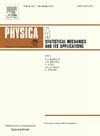An unsupervised group detection method for understanding group dynamics in crowds
IF 2.8
3区 物理与天体物理
Q2 PHYSICS, MULTIDISCIPLINARY
Physica A: Statistical Mechanics and its Applications
Pub Date : 2024-10-30
DOI:10.1016/j.physa.2024.130195
引用次数: 0
Abstract
Pedestrian groups arrive in large numbers in crowd gatherings, especially of a spiritual nature. Various studies have been done on crowd control in public spaces by analysing the behaviour of pedestrian groups. Understanding group dynamics can help better plan pedestrian facilities and large events. Many existing group sensing models primarily determine social bonding between pedestrians using spatiotemporal parameters, such as distance, directional movement, and overlapping time. However, social bonding determined based on these parameters assumes the bonding to be symmetric, spatially and temporally static and is unaffected by neighbourhood. Our study addresses the issue by relaxing such assumptions and developing an unsupervised group detection model based on potential candidates. The proposed model can handle temporal and spatial variations more effectively than those based on simple spatiotemporal parameters. The model developed is assessed both quantitatively and qualitatively. New metrics are introduced for quantitative evaluation, comparing predicted groups and ground truth instead of pedestrian pairs with ground truth. A visualisation method is developed for the qualitative assessment. Group splits and group merges are calculated to assist in understanding crowd movement patterns. Overall, this study helps in further exploring and assessing groups, which can improve understanding of crowd dynamics.
用于了解人群中群体动态的无监督群体检测方法
在人群聚集,尤其是精神性质的人群聚集时,会有大量的行人群体出现。通过分析行人群体的行为,对公共场所的人群控制进行了各种研究。了解群体动态有助于更好地规划行人设施和大型活动。现有的许多群体感应模型主要通过时空参数(如距离、运动方向和重叠时间)来确定行人之间的社会联系。然而,根据这些参数确定的社会联系假定这种联系是对称的,在空间和时间上是静态的,并且不受邻里关系的影响。我们的研究通过放宽这些假设来解决这个问题,并根据潜在候选者建立了一个无监督群体检测模型。与基于简单时空参数的模型相比,所提出的模型能更有效地处理时空变化。我们对所开发的模型进行了定量和定性评估。引入了新的定量评估指标,对预测组和地面实况进行比较,而不是对行人对和地面实况进行比较。为定性评估开发了一种可视化方法。通过计算分组拆分和分组合并,有助于理解人群移动模式。总之,这项研究有助于进一步探索和评估群体,从而加深对人群动态的理解。
本文章由计算机程序翻译,如有差异,请以英文原文为准。
求助全文
约1分钟内获得全文
求助全文
来源期刊
CiteScore
7.20
自引率
9.10%
发文量
852
审稿时长
6.6 months
期刊介绍:
Physica A: Statistical Mechanics and its Applications
Recognized by the European Physical Society
Physica A publishes research in the field of statistical mechanics and its applications.
Statistical mechanics sets out to explain the behaviour of macroscopic systems by studying the statistical properties of their microscopic constituents.
Applications of the techniques of statistical mechanics are widespread, and include: applications to physical systems such as solids, liquids and gases; applications to chemical and biological systems (colloids, interfaces, complex fluids, polymers and biopolymers, cell physics); and other interdisciplinary applications to for instance biological, economical and sociological systems.

 求助内容:
求助内容: 应助结果提醒方式:
应助结果提醒方式:


